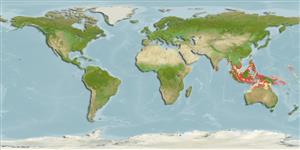分类 / Names
俗名 | 同种异名 | Catalog of Fishes(属, 种) | ITIS | CoL | WoRMS | Cloffa
Teleostei >
Eupercaria/misc (Various families in series Eupercaria) >
Haemulidae (Grunts) > Plectorhinchinae
Etymology: Diagramma: Greek, diagramma = mark out by lines (Ref. 45335); melanacrum: From the Greek melanos meaning black, and akros meaning tip or at the end - in reference to the black outer part of anal and pelvic fins and lower part of caudal fin (Ref. 44143).
More on authors: Johnson & Randall.
Environment: milieu / climate zone / depth range / distribution range
生态学
海洋 底中水层性; 深度上下限 3 - 40 m (Ref. 90102). 熱帶
Indo-West Pacific: Indonesia, Borneo and the Philippines. Also reported from Australia, Timor Sea (Ashmore Reef) and Myanmar.
中西太平洋: 印尼,婆羅洲與菲律賓。 在帝汶海中也已知來自艾甚摩堡礁。
大小 / 重量 / 年龄
Maturity: Lm ? range ? - ? cm
Max length : 45.0 cm SL 雄鱼/尚未辨别雌雄; (Ref. 48635)
背棘 (总数) : 10 - 11; 背的软条 (总数) : 22 - 24; 臀棘: 3; 臀鳍软条: 6 - 7. Tubed lateral line scales 55-57; outer row of teeth in jaws slightly enlarged, movable; swim bladder with 3 short anterior projections; third or fourth dorsal spine longest, 1.8-1.9 in head; first dorsal spine 1.7-2.3 in length of second; interspinous membrane of dorsal fin not incised; pelvic fins reaching vent or slightly beyond, 1.2-1.3 in head; body light yellow dorsally, shading to pale silvery grey on sides and ventrally, with numerous small dark brown spots, which are smaller and form oblique rows on body below lateral line; head light purplish grey with numerous small dark brown spots, opercular membrane black; dorsal fin and upper 3/4 of caudal fin with small dark spots; lower 1/4 of caudal fin black; anal and pelvic fins mainly black (Ref. 44143); dorsal and caudal fins mainly yellow, caudal fin with broad black lower edge margin, caudal fin may be slightly emarginate to truncate; body depth 2.4-2.6 in SL (Ref. 90102). Juveniles from 13.3 cm SL with spots about size of pupil on head, body, dorsal and caudal fins becoming progressively smaller and more numerous with age; juveniles and subadults up to 25.4 cm SL with narrow discontinuous wavy lines on operculum and cheeks, extending to about level of anterior margin of eye (with lines breaking up into spots in larger specimens) (Ref. 44143). Large juveniles have spots in longitudinal rows and also solid stripes (Ref. 90102).
管状的侧线鳞片 55-57; 颚中的牙齿的外部列些微地增大了, 可动的; 泳鳔有 3个短的前面突出; 第三或第四个背棘长的,1.8-1.9个头长比率; 第一背鳍棘第二个的 1.7-2.3个长; 不被呈锯齿状的背鳍的棘间膜; 腹鳍达到排泄孔或略超过,1.2-1.3个头长比率; 身体淡黄色的背面, 颜色变化成灰白的银灰色的在腹部与侧面上, 在身体上有很多的小深褐色的斑点, 那是较小的而且形成斜的列在侧线下; 头部淡的紫灰色的有很多的小深褐色的斑点,鳃盖薄膜黑色; 背鳍与上面的 3/4 尾鳍有小的深色斑点; 尾鳍黑色中的低的 1/4; 臀鳍与腹鳍鳍主要黑色.(参考文献 44143) 稚鱼来自 13.3 在头部,身体上 cm SL 有关于瞳孔的大小的斑点, 背鳍与尾鳍鳍变成渐进比较小而众多随着年龄; 稚鱼与亚成鱼向上到 25.4 在鳃盖与颊上 cm SL 有狭窄的不连续的波浪状的线, 延伸至大约眼 (具有在较大的标本中断裂成斑点的线) 的前缘的水平。 (参考文献 44143)
Juveniles in estuaries and silty reefs on open substrates with remote outcrops or reef or debris. Adults on deep reefs along walls with large caves. Often in small aggregations in depths of 30 m or more (Ref. 48635).
河口的稚鱼与淤泥的礁开放的之上有遥远的露头或礁或残砾的底部。 成鱼在深的礁沿着墙壁上有大的洞穴地方。 常见于小群鱼群在深度 30个公尺或更多中.(参考文献 48635)
Life cycle and mating behavior
成熟度 | 繁殖 | 产卵场 | 卵 | 孕卵数 | 仔鱼
Distinct pairing during breeding (Ref. 205).中西太平洋: 印尼,婆羅洲與菲律賓。 在帝汶海中也已知來自艾甚摩堡礁。
Johnson, J.W., J.E. Randall and S.F. Chenoweth, 2001. Diagramma melanacrum new species of haemulid fish from Indonesia, Borneo and the Philippines with a generic review. Mem. Queensl. Mus. 46(2):657-676. (Ref. 44143)
世界自然保护联盟红皮书 (Ref. 130435: Version 2024-2)
人类利用
工具
特别资料
下载 XML
网络资源
Estimates based on models
Preferred temperature (Ref.
123201): 27.9 - 29, mean 28.5 °C (based on 150 cells).
Phylogenetic diversity index (Ref.
82804): PD
50 = 0.5312 [Uniqueness, from 0.5 = low to 2.0 = high].
Bayesian length-weight: a=0.01820 (0.01078 - 0.03072), b=3.06 (2.91 - 3.21), in cm total length, based on LWR estimates for this species & (Sub)family-body (Ref.
93245).
营养阶层 (Ref.
69278): 3.7 ±0.5 se; based on size and trophs of closest relatives
回复力 (Ref.
120179): 中等的, 族群倍增时间最少 1.4 - 4.4年 (Preliminary K or Fecundity.).
Fishing Vulnerability (Ref.
59153): Moderate vulnerability (42 of 100).
Nutrients (Ref.
124155): Calcium = 61.8 [31.2, 245.8] mg/100g; Iron = 0.723 [0.300, 2.008] mg/100g; Protein = 18.2 [15.9, 20.4] %; Omega3 = 0.165 [0.072, 0.384] g/100g; Selenium = 45 [16, 152] μg/100g; VitaminA = 35.4 [12.8, 95.1] μg/100g; Zinc = 0.723 [0.381, 1.831] mg/100g (wet weight);
